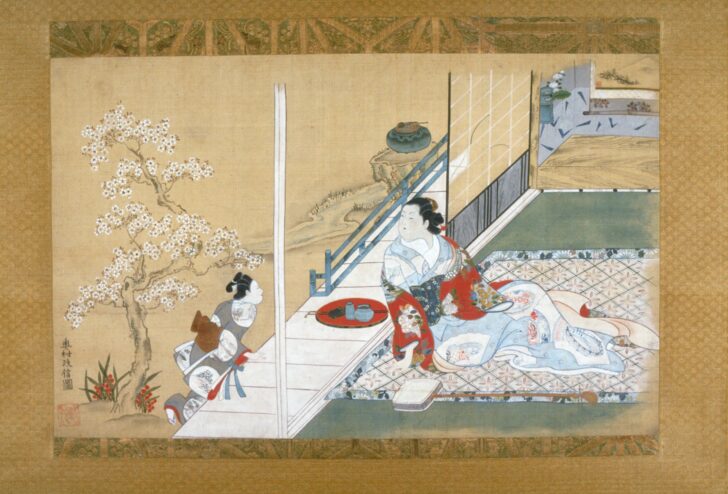Courtesan Relaxing with Attendant
Okumura Masanobu

Description
Gallery Rotation Fall 2013
Okumura Masanobu
Japan, 1686–1764
Courtesan Relaxing with Attendant
Edo period (1615–1868)
1st half of the 18th century
Hanging scroll, ink and color on silk
Museum purchase, 1963/1.94
The cherry blossom has no rivals for the affection of the Japanese. Every spring the national media eagerly follow the progress of the “cherry blossom front” as it sweeps like a monsoon from south to north. Cherry blossoms have been compared to samurai warriors because they are short-lived. More often, however, they are seen as a symbol of uninhibited pleasure or sensuality. Okumura Masanobu, a master of bijinga (“pictures of beautiful women”) paintings and prints, exploits that association in this colorful scene. An elegant courtesan turns to listen to her young servant, who leans across the veranda as though she has just rushed in—no doubt with word that the courtesan’s lover is on his way. The courtesan, like the cherry tree in full-bloom, is at the height of her beauty.
Subject Matter:
An elegantly-dressed courtesan reclining in her chambers and turning her head to listen as her attendant is leaning over the veranda to speak to her. The courtesan is comparible to the cherry tree outside her quarters, both being at the height of their beauty.
Physical Description:
A colored image depicting a woman lounging in her chambers. She wears a kimono of red and blue with an artistic stylized pattern. Outside is a cherry tree blooming and the woman's young attendant in a grey kimono.
Usage Rights:
If you are interested in using an image for a publication, please visit https://umma.umich.edu/request-image/ for more information and to fill out the online Image Rights and Reproductions Request Form.